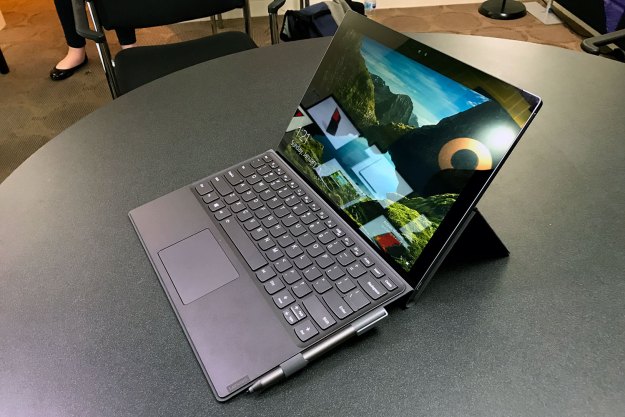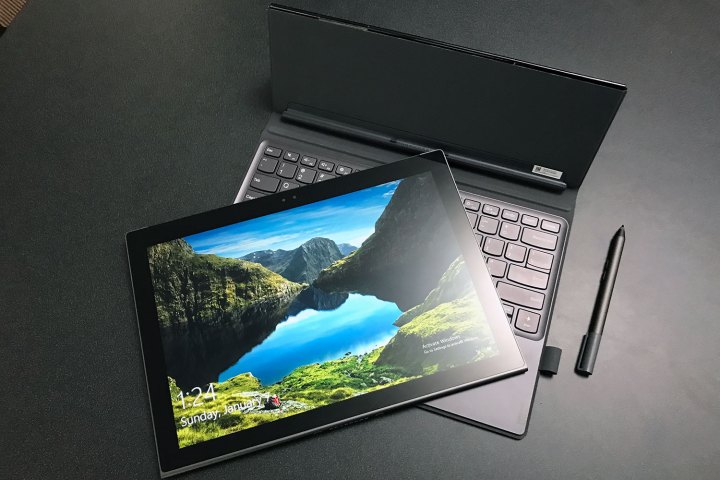
“The Miix 630 will bring LTE connectivity and 20 hours of battery to an $800 price point.”
- $800 with keyboard folio and stylus
- Versatile design
- Pixel-dense display
- 20 hours of battery life
- It’s not a looker
- A bit heavy for its size
Asus and HP were first to announce Qualcomm-powered Always Connected PCs, but there’s a third partner – Lenovo. The company announced its Lenovo Miix 630, a detachable 2-in-1, at CES 2018.
Lenovo has a long history building 2-in-1s. Its Yoga line is the most well-known, but its Miix line has been around for several years, offering a more affordable alternative to devices like the Microsoft Surface Pro. The Miix 630 unsurprisingly takes an even more mobile tack. The screen, which is also a tablet, nestles into a backlit keyboard folio. All the hardware is in the tablet itself, which doesn’t include a stand of its own, but instead relies on the folio for PC use.
It’s a design that’s new to Miix, but not unfamiliar. HP’s Envy x2, Samsung’s Galaxy Book 2, and Apple’s iPad Pro are all similar. Keyboard folios can be a bit fussy because they fold in several different ways, and the Miix 630 doesn’t solve that issue. The keyboard and stylus are a standard feature, though, which makes it easier for us to forgive this nitpick.
The entire Miix, keyboard and stylus included, weighs 2.93 pounds, and measures .6 inches thick. This is a more serious issue, because the HP Envy x2 with Qualcomm processor weighs 2.6 pounds overall, and the tablet alone is a mere 1.5 pounds. Lenovo’s Miix 630 is heavier, and felt that way when handled. The all-aluminum chassis also seemed less refined, though on the plus side, it struck us as more robust than the HP’s featherweight body.
Qualcomm’s power-sipping chip helps the small 2-in-1 manage up to 20 hours of battery life.
We saw more similarities to the HP when we handled the stylus. It’s a chunky, fat unit that’s easy to handle, and it attaches to the keyboard folio by sliding through a fabric loop. All of that’s equally true of the HP. We’re not sure we could tell the difference between the two if we weren’t told beforehand. Does that matter? Likely not. The Miix’s stylus isn’t as refined as the Surface Pen, but it felt quick and precise when we used it. That’s what’s important.
The screen is a 12.3-inch, 1920 x 1280 panel. That matches the HP Envy x2, and it provided a sharp image during our use. We also thought its colors and contrast looked good. Glare is an issue, but the screen is bright enough to mostly combat it.
Another key feature is the front-facing camera with IR support, which lets you log in to Windows 10 with your face. We love this feature, which is usually found on more expensive laptops. It’s good to find it on a relatively entry-level 2-in-1.
Fast? Fast enough
The Qualcomm Snapdragon 835 processor inside the Lenovo Miix 630 isn’t new, but it’s new to PCs, and a lot of people are curious if it’ll provide enough grunt. We haven’t had a chance to fully test the chip yet – no one has, because we’re a few months away from any hitting stores – but we’ve gone hands-on with every Qualcomm-powered Windows device announced so far.
Our verdict? It’s good enough. The performance gap is detectable if you’re picky. Apps can take an extra second to load, and animations aren’t always as smooth as they could be. It’s far from a bad experience, though, and not any different from an entry-level laptop. The Qualcomm processor is paired with 4GB or 8GB or RAM, and 64GB, 128GB, or 256GB of solid state storage. Overall, we think the Miix 630’s performance should satisfy most people.
Keyboard folios can be a bit fussy, and the Miix 630 doesn’t solve that issue.
There’s something else that’ll satisfy more than most people – battery life. Qualcomm’s power-sipping chip helps the small 2-in-1 manage up to 20 hours of battery life, and weeks of standby time. This is exactly on par with the HP Envy x2, so the Miix 630 isn’t outrunning its most direct competitor. Still, it’ll last a lot longer than any current Windows 2-in-1.
Using a Qualcomm chip also means LTE mobile data comes standard. We didn’t get a chance to test that out, but Lenovo says the Miix 630 includes support for both a standard SIM card or eSIM. When enabled, you should have access to mobile data anywhere in your carrier’s coverage.
What about the price?
The Miix 630 will be available in the second quarter of 2018 for $800. HP actually hasn’t revealed pricing on its HP Envy x2 with Qualcomm processor, but Asus’ NovaGo will also retail for $800.
We think the fate of Lenovo’s Always Connected PC will hinge on the price of the HP. We prefer the Envy x2’s look, feel, and lower weight, but HP has hinted it’ll charge more for its luxury feel. That might give the Miix 630 room to stand out as a budget option for early adopters of Always Connected PCs.
Editors' Recommendations
- This Lenovo external graphics solution does what other eGPUs can’t
- CES 2023: Lenovo’s new ThinkBook 16p has a snap-on 4K webcam
- Alienware x14 R2 and x16 hands-on review: XPS gaming laptops?
- Microsoft Surface Pro 9 vs. Lenovo IdeaPad Duet 5i: which 2-in-1 is best?
- Lenovo ThinkPad X1 Fold Gen 2 hands-on review: a sleek redo







